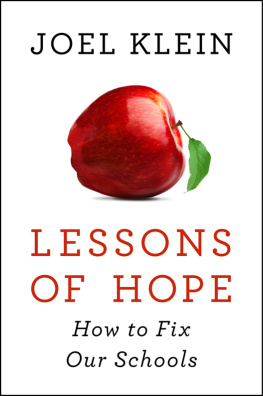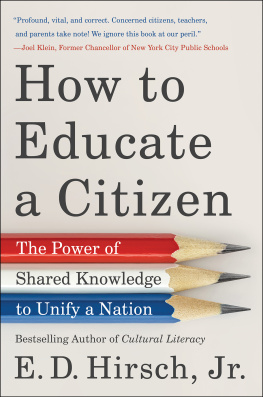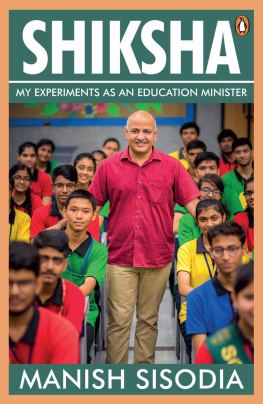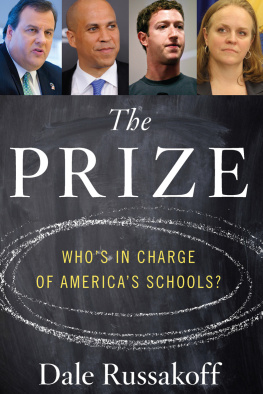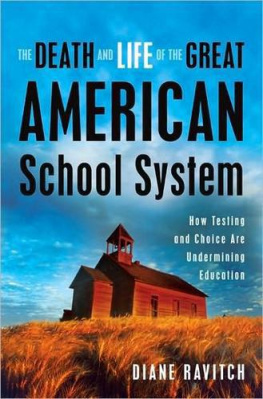v
FOR NICOLE AND JULIA
vii
CONTENTS
Guide
My first thanks go to Michael Bloomberg, who took a risk on me and gave me the opportunity of a lifetime. I will forever be grateful to him, not just for the appointment, but for the outstanding leadership, support, and encouragement he provided.
Several members of the mayors team were enormously helpful during my chancellorship. In addition to Dennis Walcott, who was a great partner, others deserving special thanks include Patti Harris, Kevin Sheekey, Howard Wolfson, Ed Skyler, Jim Anderson, and Stu Loeser.
I owe a great debt to Margaret Carlson, both for her friendship and for her willingness to recommend me to Bloomberg.
The men and women who joined our effort at the DOE merit particular mention. Some were there when I started, but many came from all over the country. This was an extraordinary group of people, lots of whom made great personal sacrifices in order to improve education for kids. There are far too many to name, but they know who they are, and, to me, they are the heroes of this story.
We received a great deal of help from community groups, foundations, and corporations that participated in numerous waysfrom opening new schools to partnering with schools to providing financial support that enabled us to do things we could not otherwise have done. The number of groups and individuals who supported our reforms is remarkable. Only in New York could this happen.
Two seasoned authors, Michael DAntonio and George Hodgman, helped me organize my thoughts and provided strong editorial help. My thanks to both.
Jonathan Burnham, Tim Duggan, Laura Brown, and the entire team at HarperCollins made many constructive suggestions and showed great patience in dealing with a rookie author.
Several people gave me comments and suggestions on earlier drafts. From among my colleagues at the Department of Education, Michele Cahill, Jim Liebman, and Dan Weisberg were generous with their time and wisdom. So, too, were my friends Marie Brenner, Ernie Pomerantz, and Gerson Zweifach, along with Bob Barnett (who also ably represented me on this book).
My daughter, Julia, is a talented writer who sharpened my prose and brought clarity to my thoughts. My assistant, Rosanne Mullaly, helped in numerous ways, as she always does.
My greatest debt goes to my wife, Nicole Seligman. She is the best editor I know, and her work on this book was invaluable. She is also the best partner I could ever have hoped for. She was my first adviser in dealing with the many tough issues that came before me as chancellor, and her love made it possible to get up every morning ready to tackle the challenges I faced and go to sleep every night knowing that, no matter how rocky things might seem, it would all be fine because she was there for me.
ix
March 28, 2008: The day brings grim news; an eighteen-year-old honor student is brutally stabbed at Brooklyns Paul Robeson High School. His life hangs in the balance.
In the wake of the stabbing, teachers at Robesonalready anxious and often discouragedare horrified, angry, and mournful. Students and parents around the city are concerned. I had known the school was a messlow graduation rates, gang violence bleeding into the school from a neighborhood now often a battleground, and a faculty close to the breaking point. As the boy fights to survive, Im tense. Each moment feels shaky.
Thank god, the boy survives, but the fate of the others at Robeson is uncertain. I set out for the school to assess the situation firsthand and to show my support for the people dealing with the aftermath, trying to rally their courage and perseverance. As I drive from lower Manhattan across the Brooklyn Bridge through the gentrified neighborhoods on the other side, I am reminded of Brooklyns transformation into a borough of haves and have-nots. Newly affluent communities rim the borough while some parts remain burned-out and decayed. Neighborhoods such as Crown Heights, where Robeson is located, resist the progress that propels the rest of the city.
x
Fear and frustration are palpable in the halls of the school. Nobody knows why the kid was targeted. Teachers say they are scared just to walk through the Robeson doors. After six years on the job as New York Citys schools chancellor, I know the scenario and how this will play out: Robeson will have to be closed and replaced.
FEBRUARY 12, 2013: IM WATCHING PRESIDENT OBAMA DELIVER his State of the Union address, turning his attention to the problems of American education. I lean forward, listening attentively as he tells the story of a school I know well, P-Tech, in Brooklynhoused in what had once been Robeson, the school where the boy was stabbed. He praises it for putting our kids on a path to a good job, noting that students there will graduate with a high school diploma and an associates degree in computers or engineering.
Change had come, kicking and screaming. How did it happen? How had the place that was once Robeson, where basic safety was imperiled, been transformed in fewer than five years into a national showcase? This seeming miracle was brought about by a strategy of change we had inaugurated years before, a program of replacing large, dysfunctional high schools in high-poverty communities with new, smaller schools built from scratch with strong community partnerships. P-Tech itself had grown out of a discussion I had with Sam Palmisano, then CEO of IBM, in late 2010, who told me the tech industry was having difficulty finding students with the skills it currently needed.
xi
I proposed we open a six-year institution in partnership with the City University of New York that would include four years of high school and two years of community college. The goal would be the development of those technology skills too often missing in students looking for work. IBM would partner with us on developing the curriculum, while also supporting the school financially and providing internships for its students. After completing their coursework, students would be eligible to take a certification test, prepared by IBM. If they passed, they would get priority placement for hiring by IBM. Palmisano agreed, and with lots of work by the teams at my department, City University, and IBM, P-Tech opened in September 2011, as my department simultaneously began the process of closing the old Robeson school.
Most remarkable is the resistance we encountered when shuttering Robeson. Despite the schools wretched performance, the students, community, and teachers union rallied behind it, angrily protesting the closure as they had in so many similar instances around the city. The students are too proud to acknowledge their schools failure, the community clings to its memories, and the teachers worry about their jobs. This is why school reform is so tough in America: the status quo, even when irreparably broken, has many defenders who will fiercely resist change.
In his speech, President Obama made clear that P-Techs success story could not be repeated without a major overhaul of public education. We need to give every American student opportunities like this, Obama noted, stating the obvious. What is not obvious to many is this: to succeed, public education needs radical rethinking. That is why I wrote this book.
xii
I WAS A CAREER LAWYER, FRESH FROM THE CLINTON ADMINISTRATION, with little background in education before these matters became my lifes work. In August 2002, I was selected as New York Citys schools chancellor. Michael Bloomberg had become the citys 108th mayor on January 1 of that year. One of his first acts was to persuade the state legislature in Albany to give him operational control over the schools, then run by thirty-two separately elected community school boards. My appointment as head of the newly created department of education surprised many, but Bloomberg wanted innovation, a leader who could bring fresh ideas from other walks of life into the discussion. He and I worked together for almost eight and a half years, profoundly changing the face of public education in the city. At virtually every turn, we encountered strong resistance by the politicians, unions, bureaucrats, and other entrenched opponents of reform.

